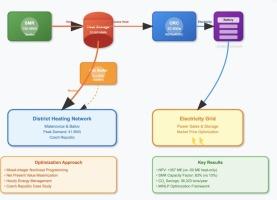Optimization of district heating systems integrated with energy storage for enhanced economic performance
IF 2.1
3区 工程技术
Q1 NUCLEAR SCIENCE & TECHNOLOGY
引用次数: 0
Abstract
A possible carbon–neutral substitute for district heating systems (DHSs) that rely on fossil fuels is the idea of a heat-only small modular reactor (SMR). However, high capital expenditures and decreased capacity factors—mainly from variations in demand in independent operations—hinder its economic sustainability. To overcome these obstacles, this research suggests an integrated strategy that combines district heating systems (DHSs), heat-only small modular reactors (SMRs), and Organic Rankine Cycle (ORC) power generation. To improve the system’s energy management, auxiliary parts, including heat storage, gas boilers, and electricity storage, are also evaluated. The optimization framework, which focuses on factors including equipment design capacity and hourly operating tactics, is described as a mixed-integer nonlinear programming (MINLP) problem. The main goal criterion is the net present value (NPV). A heat-only SMR (Teplator-150 MWt), a 20 MWe ORC power plant, a 10,000 MWth thermal energy storage unit, a 3.4 MWt gas boiler, and electricity storage with a capacity of 20 MWe/120 MWeh are all part of the ideal design for a typical DHS in Czechia with a peak demand of 41 MWt. Compared to a traditional heat-only supply system, this integrated system improved energy management, increasing the SMR’s capacity from 10% to 83%. This resulted in a 357 million euro profit instead of a 50-million-euro loss. Sensitivity analysis revealed important economic viability variables, such as the ORC system’s size and technology, interest rates, and power market prices. These results demonstrate the importance of energy management and strategic system integration in reaching financial and environmental goals.

优化区域供热系统集成的能源储存,以提高经济效益
依赖化石燃料的区域供热系统(dhs)的一个可能的碳中性替代品是一种仅供热的小型模块化反应堆(SMR)。然而,高昂的资本支出和产能因素的下降(主要来自独立运营的需求变化)阻碍了其经济的可持续性。为了克服这些障碍,本研究提出了一种综合策略,将区域供热系统(DHSs)、仅热小型模块化反应堆(smr)和有机朗肯循环(ORC)发电结合起来。为了改善系统的能源管理,还对辅助部件,包括储热,燃气锅炉和储电进行了评估。将优化框架描述为一个混合整数非线性规划(MINLP)问题,该优化框架主要考虑设备设计能力和每小时运行策略等因素。主要目标标准是净现值(NPV)。仅热SMR (Teplator-150 MWt), 20 MWe ORC发电厂,10,000 MWe带热能存储单元,3.4 MWt燃气锅炉和容量为20 MWe/120 MWeh的电力存储都是捷克典型DHS的理想设计的一部分,峰值需求为41 MWt。与传统的仅供热系统相比,该集成系统改善了能源管理,将SMR的容量从10%提高到83%。这导致了3.57亿欧元的利润,而不是5000万欧元的亏损。敏感性分析揭示了重要的经济可行性变量,如ORC系统的规模和技术、利率和电力市场价格。这些结果表明能源管理和战略系统集成在实现财务和环境目标方面的重要性。
本文章由计算机程序翻译,如有差异,请以英文原文为准。
求助全文
约1分钟内获得全文
求助全文
来源期刊

Nuclear Engineering and Design
工程技术-核科学技术
CiteScore
3.40
自引率
11.80%
发文量
377
审稿时长
5 months
期刊介绍:
Nuclear Engineering and Design covers the wide range of disciplines involved in the engineering, design, safety and construction of nuclear fission reactors. The Editors welcome papers both on applied and innovative aspects and developments in nuclear science and technology.
Fundamentals of Reactor Design include:
• Thermal-Hydraulics and Core Physics
• Safety Analysis, Risk Assessment (PSA)
• Structural and Mechanical Engineering
• Materials Science
• Fuel Behavior and Design
• Structural Plant Design
• Engineering of Reactor Components
• Experiments
Aspects beyond fundamentals of Reactor Design covered:
• Accident Mitigation Measures
• Reactor Control Systems
• Licensing Issues
• Safeguard Engineering
• Economy of Plants
• Reprocessing / Waste Disposal
• Applications of Nuclear Energy
• Maintenance
• Decommissioning
Papers on new reactor ideas and developments (Generation IV reactors) such as inherently safe modular HTRs, High Performance LWRs/HWRs and LMFBs/GFR will be considered; Actinide Burners, Accelerator Driven Systems, Energy Amplifiers and other special designs of power and research reactors and their applications are also encouraged.
 求助内容:
求助内容: 应助结果提醒方式:
应助结果提醒方式:


